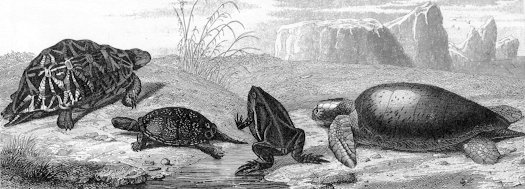The Tortoise and the Hare
Today, a Paleolithic story of the tortoise and the hare. The University of Houston's College of Engineering presents this series about the machines that make our civilization run, and the people whose ingenuity created them.
A group of anthropologists from Arizona and Israel has been digging in Italy and Israel. They've been studying a surprising Paleolithic population explosion, and they've linked it to a key discovery: Some 40,000 years ago, humans began eating differently.
For hundreds of thousands of years, much of the human diet was made up of mollusks and tortoises. And what do such creatures have in common? They're slow-moving and easy to catch. When you get hungry, you go out and pick up a turtle.
The problem is, those species are easy to kill off. Killing even seven percent of a tortoise population will upset its balance and threaten its survival. That ancient diet could work only while the population of human predators was very small.
So diet becomes an index to population. Human populations were, it seems, all small before the recent stone ages. Other evidence has shown that the population of Africa was once as small as 7000 people. It probably consisted of wide-ranging bands of 250 to 500 people -- the minimum needed to satisfy universal taboos against incest. The group that finally moved out of Africa to populate the rest of the world was probably about that size.
When the human population began increasing, its diet had to change. Vulnerable, slow-moving species could no longer support humans. Humans had to start eating the fast-moving animals -- birds and hares. It was time to invent or die off. Anthropologists start finding barbed spear tips, snares, nets, and throwing devices.
All this brings us back to the definition of the word technology. That word combines the Greek word tecnh with ology. Tecnh means art and skill in making things. Ology means the knowledge of, or the science of, or maybe the lore of. Technology is the knowledge of making things. It is sharing that knowledge. Sharing the knowledge of technique was the essential step that made us into a species defined by our constant remaking of the material world.
So anthropologists look at the cooled ashes of old fires and find, mixed in among them, bones of creatures that could once outrun us, out-fly us, and (perhaps) even out-think us. But no more. The old term hunter-gatherer divides in two. Gatherers no more, we became hunters who joined about the fire to tell one another what we had thought up today. And to do that, we needed another skill, the skill of speech. We're pretty sure that humans learned speech about the same time the bones of fast-moving prey appeared in the ashes of their campfires.
Embedded in all this is a reminder that creativity is communal; invention is sharing and serving the common good. To be anything but thinly scattered gatherers, we first define ourselves as sharers of technique. Then we go all the way with that definition. The odd corollary is that nothing halfway is possible.
I'm John Lienhard, at the University of Houston, where we're interested in the way inventive minds work.
(Theme music)
Stiner, M.C., Munro, N.D., Surovell, T.A., Tchernov, E., Bar-Yosef, O., Paleolithic Population Growth Pulses Evidenced by Small Animal Exploitation. Science, Vol. 283, January 8, 1999, pp. 190-194.
Wade, N., Of Tortoises, Hares and the Poepling of Earth. The New York Times, Science Section, Tuesday, January 12, 1999, pg. D-4.
